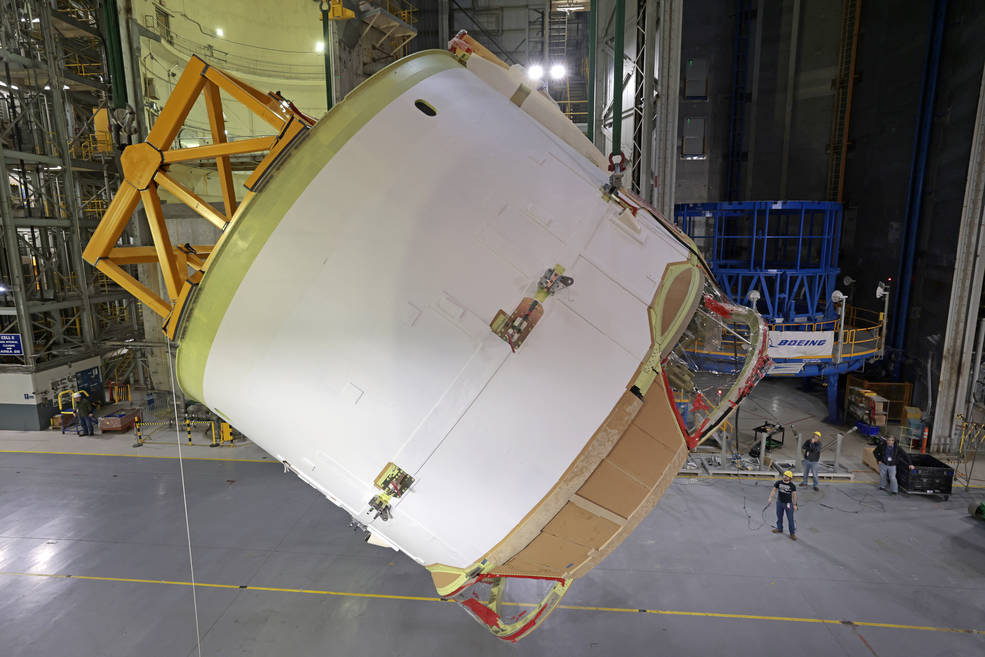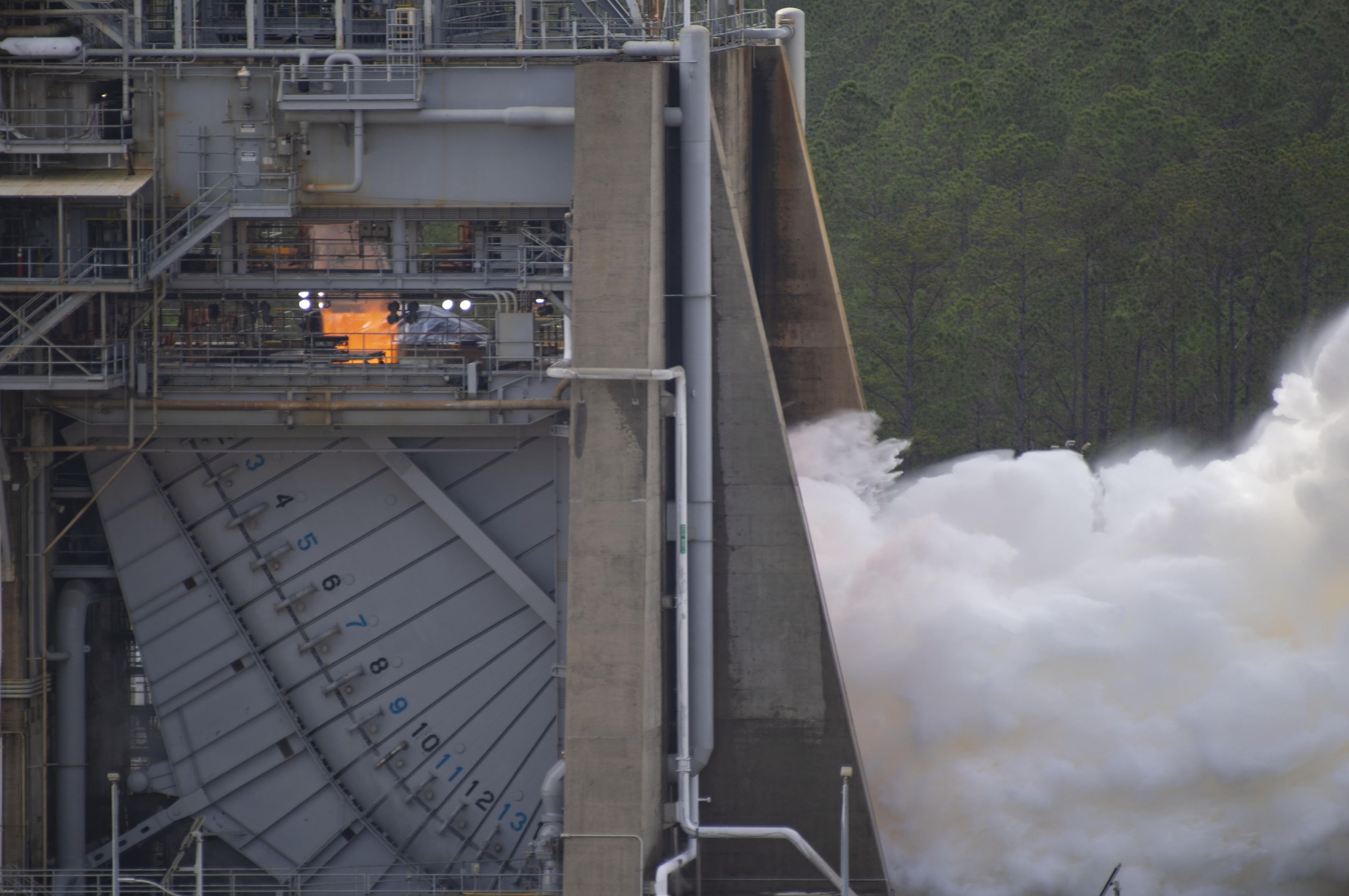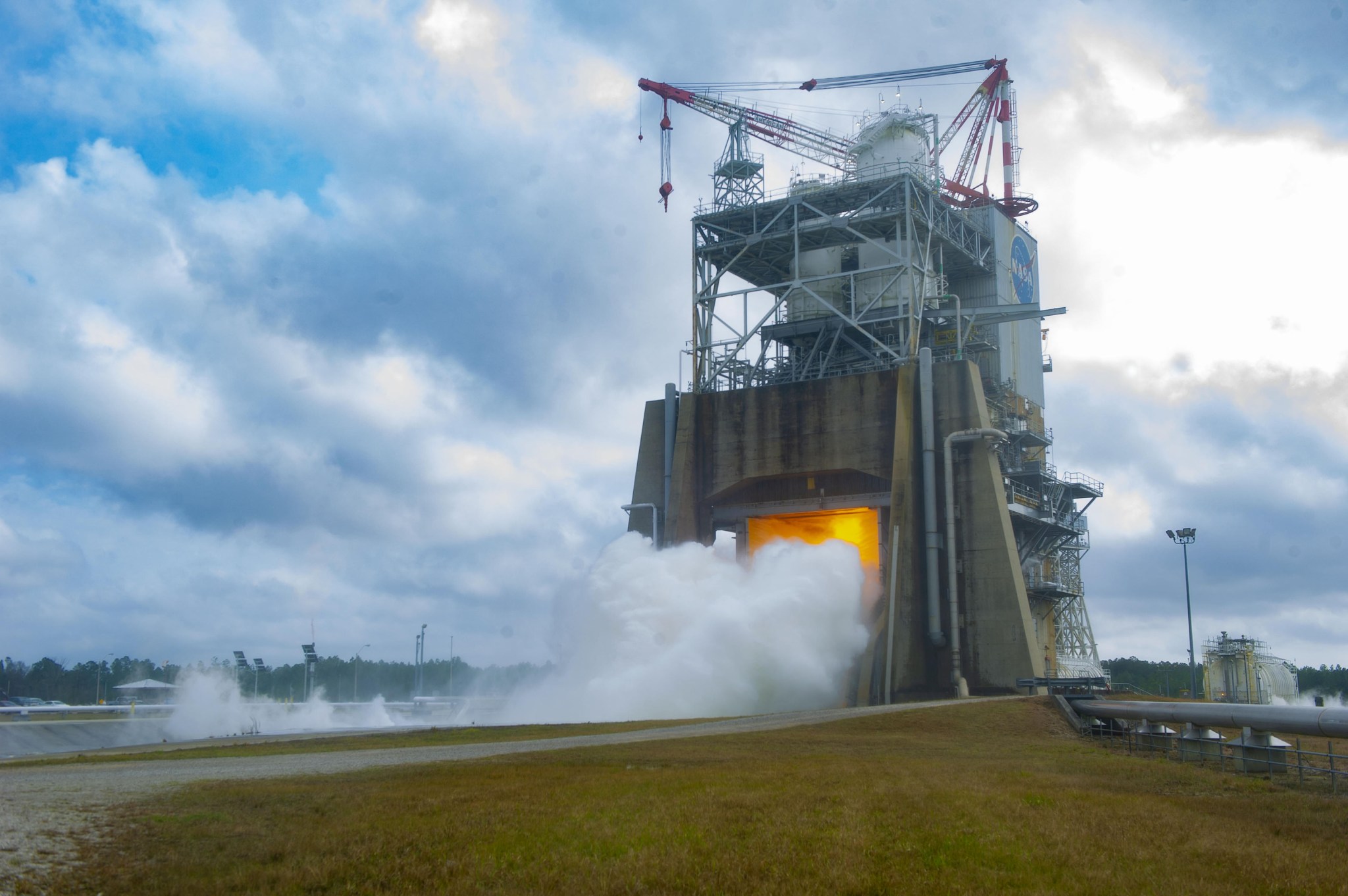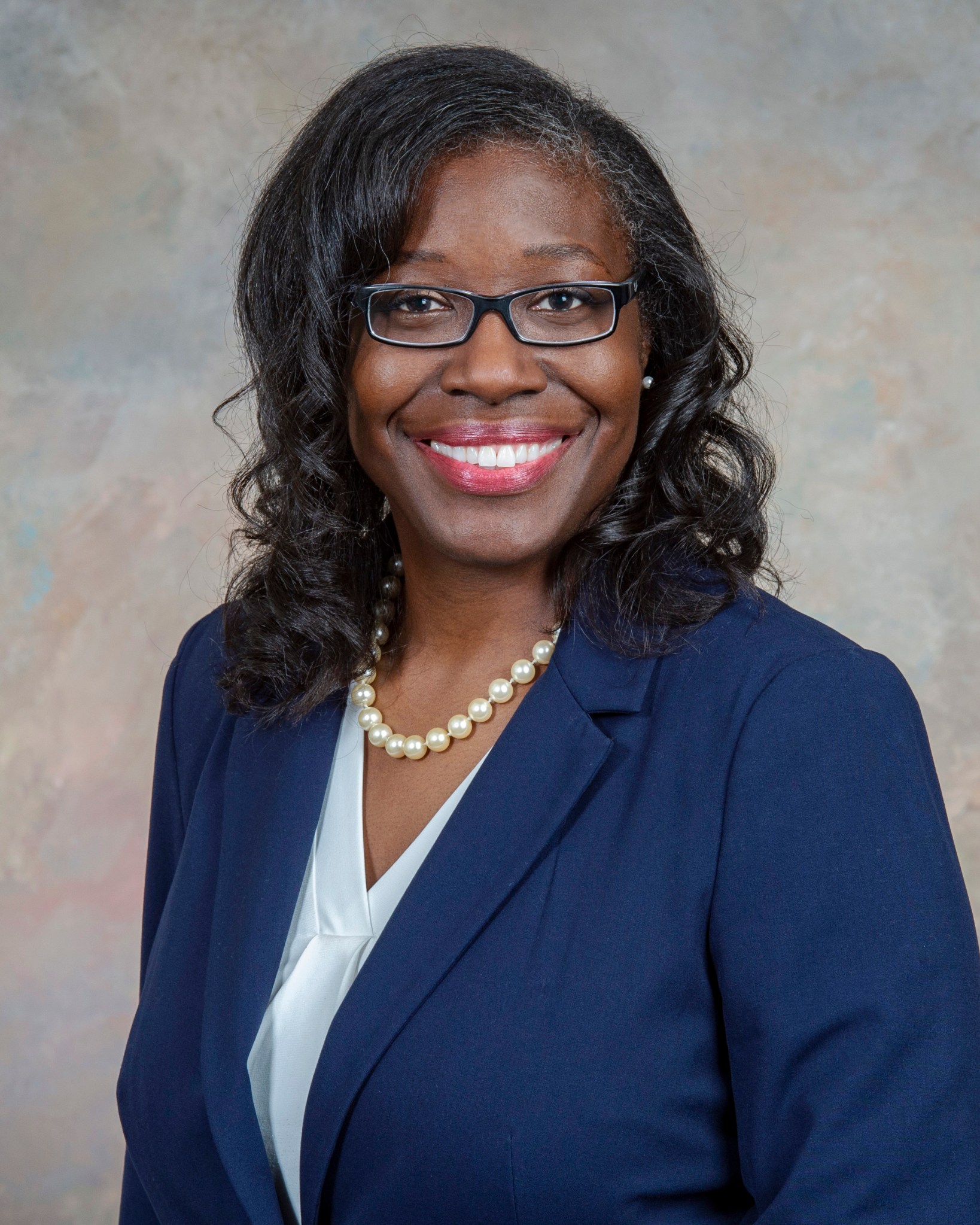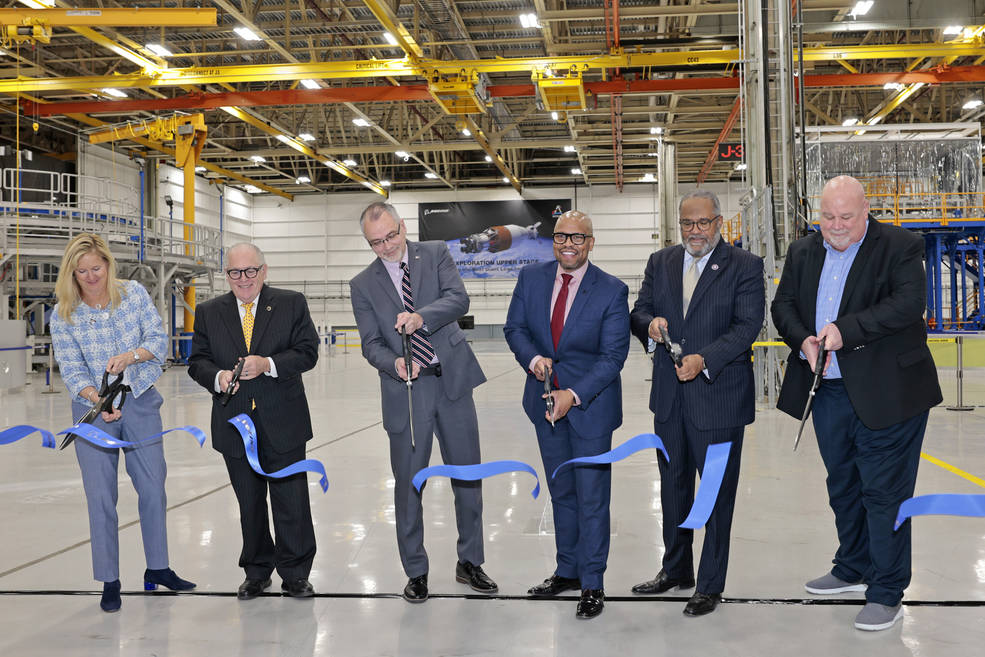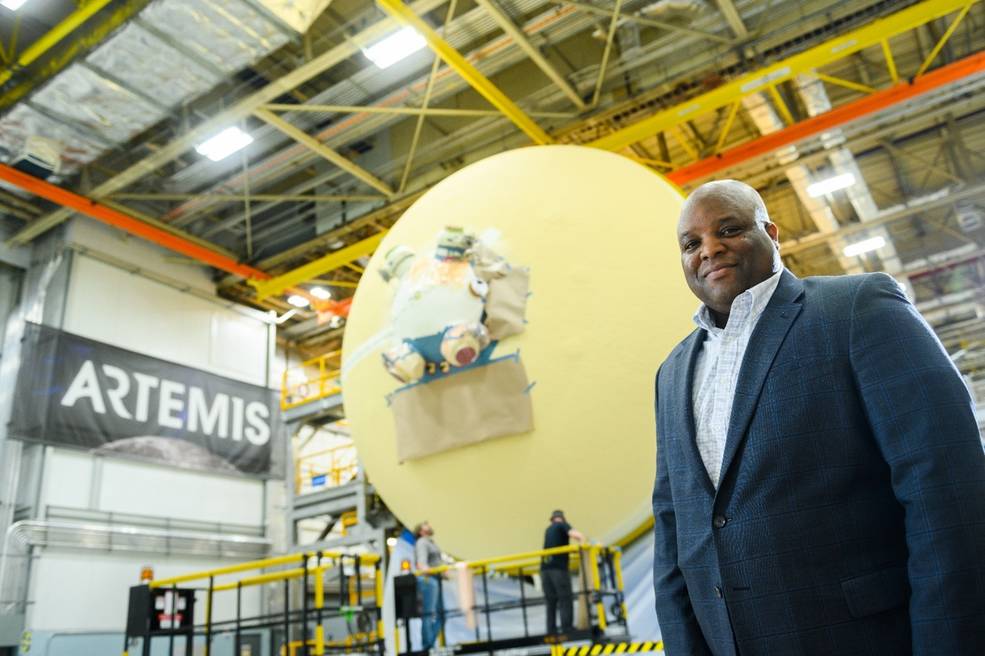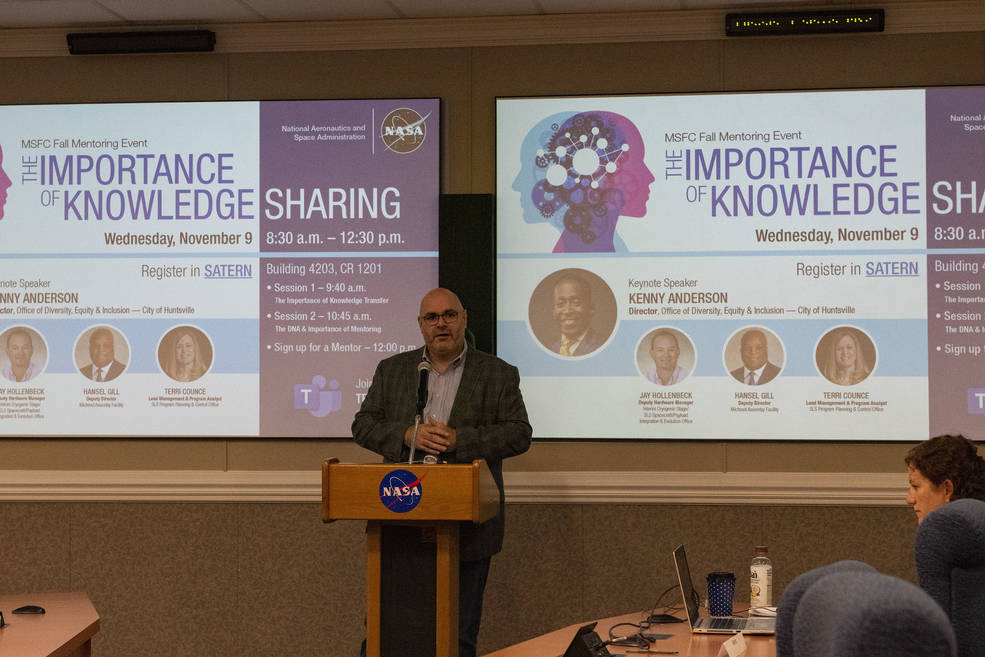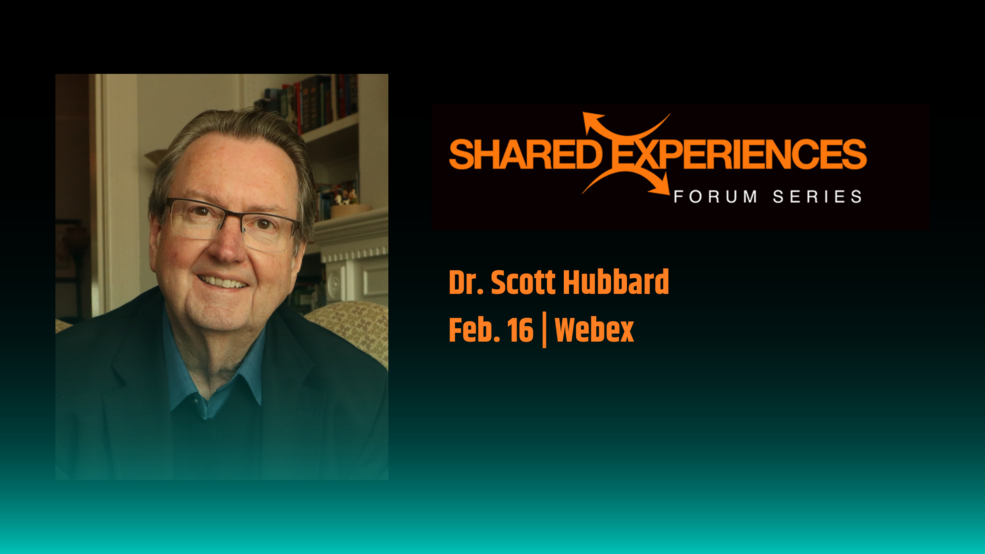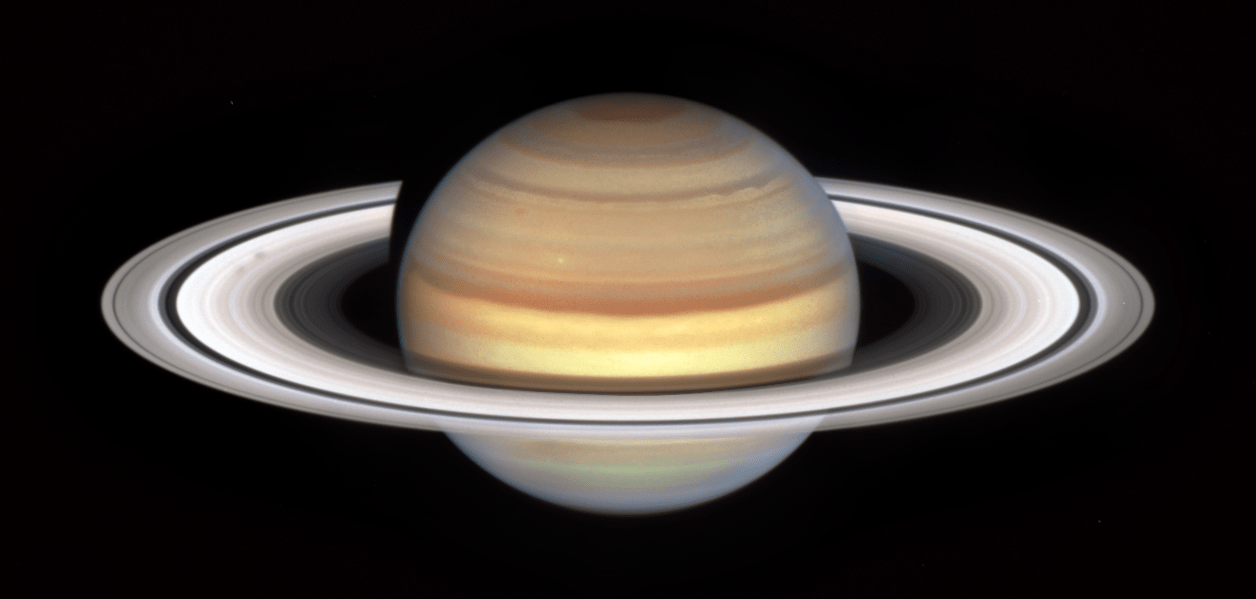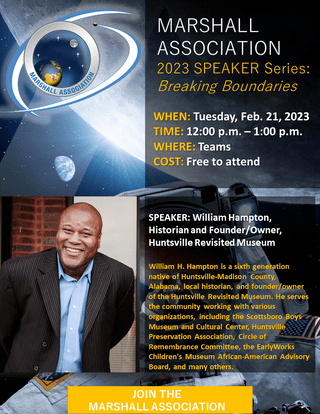The Marshall Star for February 15, 2023.
In This Week’s Star
- SLS Work Continues for Future Artemis Missions with Engine Section ‘Flip’
- NASA Conducts First 2023 Test of Redesigned Moon Rocket Engine
- Black History Month Profile: Lakiesha Hawkins
- Michoud Holds Ribbon-Cutting for Exploration Upper Stage Gray Box
- Take 5 with Hansel Gill
- Building Relationships: MECO Hosting MERGE Mentoring Event Feb. 21
- Dr. Scott Hubbard is First Mission Success Speaker of 2023
- Hubble Captures the Start of a New Spoke Season at Saturn
- William Hampton Guest for Feb. 21 Marshall Association Speaker Series
- DART’s Space Achievement Award Highlighted on ‘This Week at NASA’
SLS Work Continues for Future Artemis Missions with Engine Section ‘Flip’
Crews at NASA’s Michoud Assembly Facility rotate the engine section Feb. 11 for Artemis II, the first Artemis mission with a crew, from a vertical position to a horizontal position in preparation for final assembly and integration. This breakover, or “flip,” signals that the core stage for the next Space Launch System (SLS) rocket is nearly complete. Following the successful launch of Artemis I, SLS engineers have their eyes set on the production, assembly, and testing of Moon rockets for Artemis II, III, and IV. The Artemis II core stage is in final assembly at Michoud, and crews will soon unbox the four RS-25 engines for the mission to integrate them into the stage. The engine section is the last major structure that makes up the core stage of the rocket that will help power the Artemis II mission. (NASA/Michael DeMocker)
NASA Conducts First 2023 Test of Redesigned Moon Rocket Engine
NASA’s newly redesigned RS-25 engine for future flights of the Space Launch System (SLS) rocket, underwent its first hot fire test of the year on Feb. 8 at the agency’s Stennis Space Center.
The series of testing supports production of new RS-25 engines by lead SLS engine contractor Aerojet Rocketdyne. The new engines will help power future Artemis missions to the Moon beginning with Artemis V as NASA explores the universe for the benefit of all.
The single-engine hot fire on the Fred Haise Test Stand followed a confidence test in 2022, which tested whether all was ready to proceed with the certification series.
During the latest test, engineers fired the RS-25 engine for a full duration of about eight and a half minutes (500 seconds), the same amount of time the engines must operate to help power SLS to space. The RS-25 engine also operated at 111% power for most of the test, the same level needed to help lift SLS to orbit. The test featured a range of new components, most of which were installed for the December hot fire. One additional component – a new nozzle – was installed prior to the most recent hot fire.
Four RS-25 engines fire simultaneously to generate a combined 1.6 million pounds of thrust at launch and 2 million pounds of thrust during ascent to help power each SLS flight. NASA and Aerojet Rocketdyne modified 16 engines remaining from the Space Shuttle Program, which were proven flightworthy at Stennis for Artemis missions I through IV.
Every RS-25 engine that will help power SLS will be tested at NASA Stennis. RS-25 tests at the site are conducted by a combined team of NASA, Aerojet Rocketdyne, and Syncom Space Services operators. Syncom Space Services is the prime contractor for Stennis facilities and operations.
The SLS Program is managed by NASA’s Marshall Space Flight Center.
Through Artemis missions, NASA will land the first woman and the first person of color on the surface of the Moon, paving the way for a long-term lunar presence and serving as a steppingstone on the way to Mars.
Black History Month Profile: Lakiesha Hawkins
Each year, NASA celebrates Black History Month, highlighting the importance of the culture, traditions, and contributions of its African American workforce. The theme of this year’s observance is “#BLACK: Building a Legacy of Achievement, Connection, & Knowledge.”
Lakiesha Hawkins, deputy manager of Human Landing System (HLS) at NASA’s Marshall Space Flight Center, shares her career journey and what this month of honor and celebration means to her.
Name: Lakiesha Hawkins
Title: Deputy Manager, Human Landing System program
Hometown: Baton Rouge, Louisiana
Years with NASA: 13
My role at NASA: Helping lead NASA’s mission to return Americans to the surface of the Moon.
What my work means to me: This role has been a dream come true! The agency has entrusted me to help lead a team of experts across NASA and in industry to land the first woman and first person of color on the Moon. I appreciate the historical significance of such a monumental objective. My role has also afforded me an opportunity to tie together experiences and skills I’ve gained through working on a variety of programs over the years as an engineer, business manager, project manager, in strategy roles, leading people, and even as a community leader. I am grateful every day to be able to do such exciting work!
The people who have influenced my life and career: My greatest influence has always been my family. My parents taught me that my success depended more on grit than on sheer talent. From my grandmother, I learned fearlessness as I watched her show up in spaces with authenticity and confidence, even where others might not have believed she belonged. Finally, I’ve been fortunate to have mentors who pushed me to raise my hand for assignments outside of my comfort zone. Every period of significant growth in my career came from a time when I said yes, even when I didn’t feel I was 100% ready.
What the theme “Building a Legacy of Achievement, Connection, & Knowledge” means to me: To me, building a legacy means to reach back and bring others along as we work toward achieving the mission. Just as I have had mentors and advocates who helped me along my career path, I feel the same obligation to support others. For this reason, I spend time engaging with universities, mentoring early- and mid-career team members, and looking for ways to provide development opportunities for others.
Advancing human space exploration is a decades-long journey, and I’m grateful to play a part today in furthering the agency’s goals. A significant part of my legacy will be to help those who come after me to carry the torch farther into space!
Michoud Holds Ribbon-Cutting for Exploration Upper Stage Gray Box
From left, Vice President of GM Space, Intelligence, and Weapons Systems Kay Sears; Louisiana Secretary of Commerce Don Pierson; NASA Associate Administrator, Exploration Systems Development, Jim Free; Boeing Defense, Space, and Security CEO Ted Colbert; U.S. Rep. Troy Carter (D-La.); and NASA Space Launch System Program Manager John Honeycutt cut the ribbon at the Exploration Upper Stage Gray Box ribbon-cutting ceremony at NASA’s Michoud Assembly Facility Feb. 13. The “gray box” area is the production and processing area for the Exploration Upper Stage (EUS) that will provide in-space propulsion for the Block 1B configuration of future SLS rockets. With its four RL10 engines and larger fuel tanks, EUS will replace the Interim Cryogenic Propulsion Stage (ICPS) to send astronauts and large payloads to the Moon on a single mission. (NASA/Michael DeMocker)
Take 5 with Hansel Gill
By Matt Higgins
While the recent successful Artemis I mission traversed 1.4 million miles, Hansel Gill’s path from his childhood home to his career at NASA spanned a much shorter distance.
Gill grew up in Huntsville. His aunt, Dr. Esther Gill, who was like a mother to him, was a professor at Oakwood University in Huntsville. She introduced him to Pathways, a program that introduces students to potential careers at NASA.
That introduction was the beginning of what Gill calls an amazing ride, shared with many people and with many more exciting experiences to come as he continues his career as deputy director at NASA’s Michoud Assembly Facility.
Question: What are your primary responsibilities as Michoud deputy director?
Gill: My primary responsibility is to oversee Michoud, which provides the crucial infrastructure where elements of NASA’s Space Launch System (SLS) and Orion spacecraft are assembled. Michoud also provides facilities for non-NASA governmental and commercial technology-based industry tenant operations. An important attribute of my role is developing a healthy, dynamic, robust culture within the organization and working closely with senior leaders on several points of emphasis. That includes bolstering the safety culture for the workforce; supporting mission success; creating an environment where employees embrace ownership and accountability and possess the resources to perform their jobs well; and fostering an environment where employees are empowered to take action and feel open to communicate issues and barriers readily to leadership.
Question: How did your previous roles prepare you for your current role?
Gill: I began my career at NASA in metallic materials engineering within the Materials and Processes Laboratory. My background is flight hardware development and production; My first introduction to Michoud was during the Constellation program. Michoud provides crucial infrastructure where hardware development and production systems are realized. It’s the other side of the same coin, so to speak. So, while I recognize the distinctly different functions between site management and hardware production, I use my production background to complement Michoud operations that support spaceflight hardware systems for NASA. For the past 60 years, Michoud has been providing this capability for the agency. From the Saturn program, to shuttle, and now the Artemis program, all NASA human spaceflight systems have come through New Orleans and through our facility at Michoud. It’s a special place.
Question: What upcoming events at Michoud are you most excited about and why?
Gill: Large-scale spaceflight hardware production is one of my favorite things in the work setting, and that is what we specialize in at Michoud. The hardware production milestones are what get me excited.
We had the Feb. 13 ribbon-cutting for the North Gray Box, a newly modified manufacturing space for Exploration Upper Stage (EUS). The ribbon-cutting event signifies the start of production for EUS at Michoud. With Orion spacecraft manufacturing and SLS Core Stage assembly in flow at Michoud for the past several years, standing up a new production line and enhanced capability at Michoud for EUS is a significant achievement and a reason for anticipation and enthusiasm for Michoud and the SLS program.
Another event I’m looking forward to is the major join of the core stage engine section to the top four-fifths of the rocket. The top four-fifths comprises the forward skirt, liquid oxygen tank, intertank, and liquid hydrogen tank. When the engine section/boattail is mated to the top four-fifths, the core stage rocket is almost complete. Core stage engines are then installed, final check-outs performed, and preparations for shipment begin. Right on the heels of the outstanding launch of Artemis I, the core stage for Artemis II is just about ready for the barge ride to Kennedy Space Center. That’s exciting to me and I’m really looking forward to the start of that work.
Question: You earned the 24th STEM Global Competitiveness Conference Black Engineer of the Year Award – Modern Day Technology Leader distinction. What advice do you have for people of color considering or recently entering the field of engineering?
Gill: Our Marshall Space Flight Center leadership team is committed to nurturing an environment where all voices are heard, where differences in our backgrounds and perspectives are celebrated, and creating spaces where diversity, equity, and inclusion are valued attributes. Acknowledging that it’s a work in progress, I count myself as a change agent on this journey, continuing to strengthen those cultural norms, as should many reading this article. We all have a part to play, don’t we?
As for advice: A, find mentors and learn from their experiences. It’s your job to initiate those relationships. B, consider joining an employee resource group or multiple groups that align with your interests or maybe even to learn more about other communities. C, authenticity is key. The uniqueness of who you are as an individual is the difference-maker. No one else can make the impact on this world that you are solely gifted to deliver. Bring your best. The world needs it.
Question: What advice do you have for engineers who are considering or who have recently moved into a leadership role?
Gill: Honestly, this is still a growth area for me. Engineers want to roll up their sleeves and start solving the problem and it’s hard to resist that urge. I am learning the importance of investing in the development of our team members. That development comes through when the team takes ownership of the solution, learning to work through the issues that arise. As leaders, we make resources available; we provide mentoring; we are the sounding board at times; and we can provide the top cover, when needed, as the team works through the technical challenges. I’ve learned that approach makes for a stronger, more resilient organization and reinforces the culture where our workforce can thrive.
Higgins, a Manufacturing Technical Solutions Inc. employee, works in communications at Michoud Assembly Facility.
Building Relationships: MECO Hosting MERGE Mentoring Event Feb. 21
By Wayne Smith
An employee resource group at NASA’s Marshall Space Flight Center wants to give early career team members a boost by matching them with mentors.
The Marshall Early Career Organization (MECO) is hosting a hybrid mentoring event Feb. 21. The Mentoring Employees to Realize Goals and Experiences, or MERGE, launch meeting is for civil servants and will be from 10 a.m. to noon in Building 4316 (Activities Building).
MERGE aims to connect early-, mid-, and late-career Marshall professionals to foster professional growth. The MERGE Match app is a networking tool that opens the door to mentoring in areas such as leadership, technical skill growth, work/life balance, and more. The event will walk attendees through how to create a profile in MERGE Match and will also include table mentoring sessions with mentors.
Marshall Deputy Director Joseph Pelfrey, the event’s opening speaker, said knowledge sharing is critically important to maintaining a “learning culture” as the center’s strategy for the future is implemented.
“Mentoring is an important component of that process, especially for our early career employees, and is a priority for Marshall leadership,” Pelfrey said. “We each have a responsibility to share our experiences and offer valuable insight as mentors and leaders to ensure we prepare those who will come behind us.”
MECO council member Michael Smith, a program analyst at Marshall, said finding a mentor can be challenging, especially for an early career employee. MERGE Match allows mentors and mentees the opportunity to build online profiles and search for matches in an easy-to-use system. This helps mentors and mentees find the right match quickly so they can get a head start on building a successful working relationship.
“We are going to demonstrate this new tool NASA is using to facilitate smoother mentor/mentee matching and have a good time doing it,” Smith said. “We will also have opportunities to join in-person and online group mentoring sessions with senior employees at Marshall. Before the mentoring sessions we will highlight some good, bad, and ugly mentor/mentee relationships through humorous skits.”
Smith said MECO is encouraging all Marshall civil servants to participate in the event and learn more about the MERGE Match app.
“This has been a great team effort driven by volunteers from across Marshall and the agency,” Smith said. “Mentoring is something that Marshall and agency leadership takes very seriously.”
Visit here to register for in-person or online attendance. Those attending virtually will receive a Teams link after registration. Attendees can fill out their mentor/mentee profile here.
Visit Inside Marshall for more information about the event.
Smith, a Media Fusion employee and the Marshall Star editor, supports Marshall’s Office of Strategic Analysis & Communications.
Dr. Scott Hubbard is First Mission Success Speaker of 2023
Dr. Scott Hubbard will be the Mission Success is in Our Hands virtual Shared Experiences Forum speaker from 11:30 a.m. to 1 p.m. Feb. 16. His presentation is entitled “Ambition and Risk: The Columbia Shuttle Tragedy.” Hubbard chairs the SpaceX Commercial Crew Safety Advisory Panel. He is the former director of NASA’s Ames Research Center, former director of the agency’s Mars Program, and he founded NASA’s Astrobiology Institute. Hubbard also created Stanford University’s Center of Excellence for Commercial Space Transportation. Join the meeting via Webex here. Mission Success is in Our Hands is a safety initiative collaboration between NASA’s Marshall Space Flight Center and Jacobs Engineering. (NASA)
Hubble Captures the Start of a New Spoke Season at Saturn
New images of Saturn from NASA’s Hubble Space Telescope herald the start of the planet’s “spoke season” surrounding its equinox, when enigmatic features appear across its rings. The cause of the spokes, as well as their seasonal variability, has yet to be fully explained by planetary scientists.
Like Earth, Saturn is tilted on its axis and therefore has four seasons, though because of Saturn’s much larger orbit, each season lasts approximately seven Earth years. Equinox occurs when the rings are tilted edge-on to the Sun. The spokes disappear when it is near summer or winter solstice on Saturn. (When the Sun appears to reach either its highest or lowest latitude in the northern or southern hemisphere of a planet.) As the autumnal equinox of Saturn’s northern hemisphere on May 6, 2025, draws near, the spokes are expected to become increasingly prominent and observable.
The suspected culprit for the spokes is the planet’s variable magnetic field. Planetary magnetic fields interact with the solar wind, creating an electrically charged environment (on Earth, when those charged particles hit the atmosphere this is visible in the northern hemisphere as the aurora borealis, or northern lights). Scientists think that the smallest, dust-sized icy ring particles can become charged as well, which temporarily levitates those particles above the rest of the larger icy particles and boulders in the rings.
The ring spokes were first observed by NASA’s Voyager mission in the early 1980s. The transient, mysterious features can appear dark or light depending on the illumination and viewing angles.
“Thanks to Hubble’s OPAL program, which is building an archive of data on the outer solar system planets, we will have longer dedicated time to study Saturn’s spokes this season than ever before,” said NASA senior planetary scientist Amy Simon, head of the Hubble Outer Planet Atmospheres Legacy (OPAL) program.
Saturn’s last equinox occurred in 2009, while NASA’s Cassini spacecraft was orbiting the gas giant planet for close-up reconnaissance. With Cassini’s mission completed in 2017, and the Voyager spacecrafts long gone, Hubble is continuing the work of long-term monitoring of changes on Saturn and the other outer planets.
“Despite years of excellent observations by the Cassini mission, the precise beginning and duration of the spoke season is still unpredictable, rather like predicting the first storm during hurricane season,” Simon said.
While our solar system’s other three gas giant planets also have ring systems, nothing compares to Saturn’s prominent rings, making them a laboratory for studying spoke phenomena. Whether spokes could or do occur at other ringed planets is currently unknown. “It’s a fascinating magic trick of nature we only see on Saturn – for now at least,” Simon said.
Hubble’s OPAL program will add both visual and spectroscopic data, in wavelengths of light from ultraviolet to near-infrared, to the archive of Cassini observations. Scientists are anticipating putting these pieces together to get a more complete picture of the spoke phenomenon, and what it reveals about ring physics in general.
The Hubble Space Telescope is a project of international cooperation between NASA and ESA. NASA’s Goddard Space Flight Center manages the telescope. The Space Telescope Science Institute (STScI) in Baltimore conducts Hubble science operations. STScI is operated for NASA by the Association of Universities for Research in Astronomy, in Washington, D.C.
NASA’s Marshall Space Flight Center was the lead agency field center for the design, development, and construction of the space telescope.
William Hampton Guest for Feb. 21 Marshall Association Speaker Series
William Hampton, historian and founder/owner of the Huntsville Revisited Museum, will be the guest speaker for the Marshall Association Speaker Series on Feb. 21. The meeting topic follows this year’s theme of Breaking Boundaries, and is from noon to 1 p.m. It can be heard via Teams link here. Hampton serves the community working with various organizations, including the Scottsboro Boys Museum and Cultural Center, Huntsville Preservation Association, Circle of Remembrance Committee, EarlyWorks Children’s Museum African American Advisory Board, and more. The Marshall Association is a professional employee service organization that includes civil service employees, retirees, and contractors. For more information on the Marshall Association and how to join, visit their page on Inside Marshall. Hampton is also scheduled to speak at Marshall’s Black History Month program Feb. 22 at 10 a.m. (NASA)
DART’s Space Achievement Award Highlighted on ‘This Week at NASA’
NASA’s Double Asteroid Redirection Test (DART) team has been selected to receive the Space Foundation’s 2023 Space Achievement Award. The award is highlighted in “This Week @ NASA,” a weekly video program broadcast on NASA-TV and posted online.
Last year, the DART spacecraft successfully collided with, and changed the course of an asteroid during the first-ever planetary defense test mission. Johns Hopkins Applied Physics Defense Test Laboratory manages the DART mission for NASA’s Planetary Defense Coordination Office as a project of the agency’s Planetary Missions Program Office, which is at NASA’s Marshall Space Flight Center.
View this and previous episodes at “This Week @NASA” on NASA’s YouTube page.


























